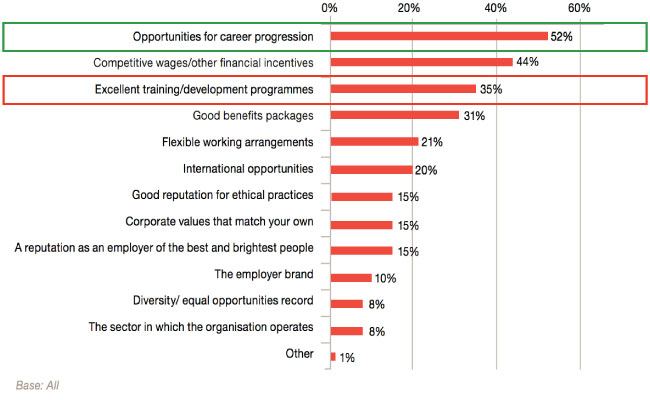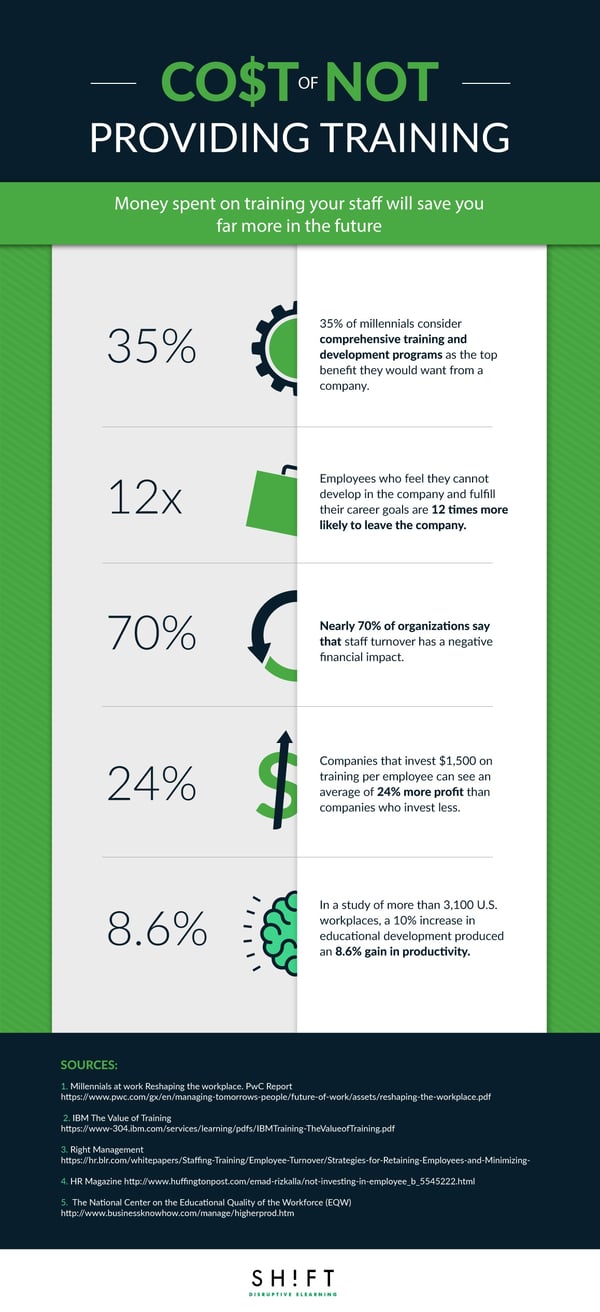Ignoring the training and development of your employees can lead to decreased productivity, higher turnover rates, and a negative impact on morale. Not only does this result in increased hiring and training costs, but it also limits the potential growth of your employees and the company as a whole. The cost of not investing in the growth and development of your employees far outweighs the cost of providing training opportunities."
It's important for managers to understand that employees are not disposable and that investing in their growth and development is crucial to the success of the organization. Providing opportunities for professional development, training programs, and regular feedback and coaching can help employees become more skilled and confident in their roles.
This not only leads to increased productivity, but it also boosts employee satisfaction and engagement, which can improve employee retention and reduce turnover rates. In the long run, investing in employee development will save companies time, money, and resources, and ultimately contribute to the overall success and growth of the organization.
So, next time you're faced with the decision to "throw out the lamp" or invest in the growth of an existing employee, remember that fixing the bulb is not only more cost-effective but also leads to a brighter future for both the employee and the organization.
Michael Leboeuf in his book "The great principle of management" warns of the dangers of ignoring training:
"If you believe that training is expensive, it is because you do not know what ignorance costs. Companies that have the loyalty of their employees invest heavily in permanent training programs and promotion systems. "
The issue is that many companies approach employee training as a cost instead of an investment. This leads to a lack of motivation and proper utilization of company resources, which in turn causes waste. In the service industry, for instance, inadequate training can result in poor customer interactions and decreased customer retention. These factors can negatively impact employees, the company, and ultimately, clients.
Read more in this article: Take Your Customer Training Online: 6 Best Practices for Success
Now is the time to reassess your strategies and adopt new approaches within your company. Keep reading to discover five reasons why neglecting employee training can have a negative impact on your bottom line and overall company performance.
1) Investing in Employee Happiness Pays Off
Investing in employee training and happiness is not just an act of kindness - it directly contributes to a company's success. Happy employees have been shown to be more productive, engaged, and loyal, leading to improved business outcomes.
Today's workforce, particularly the younger generation, places a high value on training and career advancement opportunities. A survey by PwC found that training and development opportunities ranked highly among characteristics that make an organization appealing to work for.

On the other hand, untrained and dissatisfied employees are more likely to become frustrated and disengaged, leading to decreased performance and a higher risk of turnover. However, it's a common misconception that investing in employee training will result in employees leaving for other opportunities. In reality, training helps employees feel valued and fulfilled in their roles, and can even attract higher-quality candidates.
In addition to long-term benefits, training also offers short-term gains. Trained employees are able to interact more effectively with customers, answer questions without the need for manager assistance, and work more efficiently due to a deeper understanding of their roles and responsibilities. This leads to improved customer satisfaction and a smoother work environment.
According to an IBM study, employees who feel they are unable to grow and reach their career goals within a company are 12 times more likely to leave.
Additionally, investing in training has immediate benefits for employees' interaction with customers. Trained employees are equipped with the knowledge and skills to handle customer inquiries and resolve issues, without having to rely on management assistance. This not only improves customer satisfaction but also frees up management time to focus on other tasks.
Moreover, training leads to a deeper understanding of the job and responsibilities, resulting in more efficient work. Employees are better equipped to work effectively and efficiently, and to collaborate and communicate with management. This creates a positive work environment and leads to increased employee engagement and motivation.
Overall, investing in employee training is a win-win for both the employees and the company. It leads to happier and more productive employees, improved customer satisfaction, and a stronger bottom line.
Also read: Motivate Employees to Participate in Training: 8 Ideas
2) Training and Retaining Current Employees is More Cost-Effective Than Hiring New Ones
The cost of hiring a new employee can be quite significant, as it can add up to 30% of the employee's salary. For instance, if an employee makes $40,000 per year, the cost of hiring a new employee could be around $12,000. [1]
On the other hand, training an existing employee is far less expensive and time-consuming. By investing in the training and development of current employees, companies can avoid the high costs associated with hiring and training new employees. The cost of recruitment and training for new hires often exceeds the cost of training existing employees, which can be a few hundred dollars, and requires far less time.
Moreover, the cost of turnover can also add up quickly, especially for companies with a high turnover rate. Rehiring costs typically represent 12% of a company's expenses, with up to 40% for businesses that have a high turnover rate. [2]
A study conducted by Right Management confirmed this, as nearly 70% of organizations reported that staff turnover has a negative financial impact due to the cost of recruiting, hiring, and training a replacement employee, as well as the overtime work of current employees that is required until the organization can fill the vacant position [3]. In conclusion, investing in training and retaining current employees is more cost-effective and financially beneficial for organizations in the long run.
Additional Read: The Cost of Hiring the Perfect Candidate vs. Training an Existing Employee
3) Trained Employees Drive Improved Performance
Your employees are the driving force behind your business, and investing in their development and training can lead to improved performance. When employees struggle with their tasks, it not only affects their job satisfaction but also reflects negatively on the business and hurts its bottom line.
Proper training can help employees feel more confident and capable in their roles, reducing the time they spend searching for information and minimizing the chances of errors and mistakes. By providing clear expectations and guidelines, employees can work smarter and more efficiently, ultimately reducing the time and cost of correcting mistakes.
In today's technology-driven world, offering online training courses is an efficient and cost-effective way to provide employees with the skills and knowledge they need to excel in their roles. These flexible and self-paced programs can be easily integrated into an employee's schedule, making it convenient for them to continue learning and developing.
Read more: 5 Secrets to Increase Employee Engagement With Technology
Investing in employee development and training is not just a nice-to-have, it's a must-have. The cold, hard fact is that companies that prioritize employee development see significantly higher median revenue per employee. According to a recent study, companies that prioritize employee development make median revenue of $169,100 per employee, compared to companies that don't make $82,800 per employee - a difference of more than half. [4]
More Numbers to Know
According to HR Magazine companies that invest $1,500 on training per employee can see an average of 24% more profit than companies that invest less.
Additionally, a study of 2500 businesses done by ATD, found that companies that offer thorough training had more than twice the amount of income per employee over firms that offered less training. They also create a 6% higher return for shareholders when training per employee is increased by $680. [5]
Also read: 10 Statistics on Corporate Training and What They Mean for Your Company’s Future
4) Effective Training Equals Increased Productivity
Training is no longer about sending all managers away for a weekend conference or sending anyone to an 8-hour-long lecture in a hotel. Effective training needs to be tailored to employee and business needs and to be an ongoing venture.
Competition from around the globe and ever-changing technology mean that skills need to be regularly updated to keep your workforce ready and able to support your company. Your Human Resources Department should make it a priority to integrate processes to encourage and promote employee education and skill development while also keeping the amount of time spent away from work to a minimum.
This is where eLearning courses come to the rescue. e-Learning courses are more flexible, allowing employees to access the training at their own pace and schedule, reducing the time they spend away from work. The condensed format of eLearning courses also makes the information more manageable and increases the chances of retention. Moreover, effective training fosters employee loyalty and engagement, leading to increased productivity. A study by the National Center on the Educational Quality of the Workforce (EQW) found that a 10% increase in educational development resulted in an 8.6% gain in productivity.
Productivity is also increased because effective training makes employees feel valued and empowered, which fosters loyalty and engagement with the company that provides that training. A study by the National Center on the Educational Quality of the Workforce (EQW) supports this with its finding that a 10% increase in educational development produced an 8.6% gain in productivity. [6]
Also read: Facts and Stats That Reveal The Power Of eLearning [Infographic]

Before forgoing training always consider how much more expensive it is NOT to train. Consider productivity loss, the cost of employee turnover, and lost customers due to mistakes made by improperly trained employees. Your employees’ training and happiness are just as much an asset as the workers themselves.
REFERENCES:
[1] Why Retraining Staff is better than Hiring New
[2] Employee Retention: The Real Cost of Losing an Employee
[4] Why Your Nonexistent Talent Management Strategy is Costing You Money – And How to Fix It Now
[5] Not Investing in Employees
[6] Training and Development Leads to Higher Productivity and Retention
[7] Strategies for Retaining Employees and Minimizing Turnover



